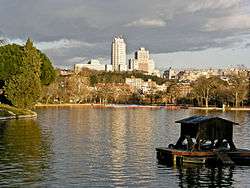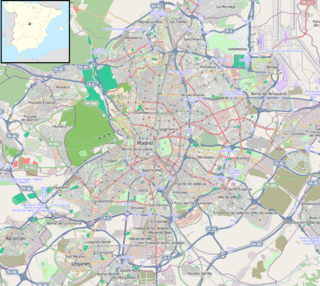Casa de Campo
The Casa de Campo (Spanish pronunciation: [ˈkasa ðe ˈkampo], for Spanish: Country House) is the largest public park in Madrid. It is situated west of central Madrid, Spain. It gets its name 'Country House' because it was once a royal hunting estate, located just west of the Royal Palace of Madrid. It was created in the early 16th century for use by the royal family and nobility, and was opened to the public in 1931 when it became a public park. Today, it is a popular green space and weekend destination for Madrid residents.
| Casa de Campo | |
|---|---|
 Lake in Casa de Campo with Plaza de España | |
 Casa de Campo  Casa de Campo | |
| Type | Public park |
| Location | Madrid, Spain |
| Coordinates | 40.42291°N 3.75595°W |
| Area | 17.23 square kilometres (4,260 acres) |
| Created | 1 May 1931 |

Its area is 1,722.6 hectares (4,257 acres), about five times the size of New York's Central Park or twice the size of Paris' Bois de Boulogne.[1] The Casa de Campo is linked to the Parque del Oeste by the Teleférico de Madrid, a gondola lift.[2]
Overview
An amusement park, the Parque de Atracciones de Madrid, and the Madrid Zoo are located inside the park. It is common for families to spend time in the park, looking at the wildlife that may be seen occasionally seen around the park with deer, rabbits, and different kinds of birds being the most common.
In 1936–39, during the Spanish Civil War, the front lines of the Siege of Madrid ran through the Casa de Campo, where the Republicans had halted a nationalist offensive in November 1936.
The park can be accessed via the Teleferico, a gondola with pick up point inside the Parque del Oeste on the west end of Madrid. The drop-off point houses a restaurant with an overlook of Madrid, playgrounds (both inside and outside), and access to Casa de Campo's many trails. The trails crisscrossing the park that are great for running, walking, and mountain biking. A lot of the less frequented parts of the park showcase Madrid's natural semi-arid beauty with red soil and scruffy pine trees. The altitude is elevated just like the rest of Madrid with quite a few hills inside the park.
The park has had a bad reputation of being a place for prostitutes, most of whom are not Spanish and imported for the sex trade.[3][4][5] However, Madrid's chief prosecutor has denied the police authority to enforce a more modest dress code, despite complaints about sex workers wearing little clothing.[6][7] Due to the park's size, there are still problems but the volume is a lot less with different enforcement measures in place and the rerouting of commuter traffic outside of the park.
References
- Web oficial de turismo de Madrid. "Casa de Campo". Retrieved 31 May 2019.
- "TPH 2S Rosales - Casa de Campo". remontees-mecaniques.net (in French). Retrieved 9 August 2017.
- ""Europe's brothel" Spain seeks solutions to prostitution". Khaleej Times. 2006-02-25. Archived from the original on 2006-08-10. Retrieved 2012-08-30.
- "African Women Being Sold Into European ''Sex Slavery''". Digitaljournal.com. 2001-03-14. Retrieved 2012-08-30.
- Tremlett, Giles (2001-02-28). "African women tricked into sex slavery in Spain". The Guardian. London. Retrieved 2012-08-30.
- Boulware, Jack (2000-07-05). "Hookers at the playground". Salon.com. Retrieved 2012-08-30.
- "Madrid Prostitutes Cleared To Dress Down". Pqasb.pqarchiver.com. 2000-06-28. Retrieved 2012-08-30.
External links
- Parque de Atracciones de Madrid (in Spanish)
- Zoo de Madrid (in Spanish)
- Teleferico
- Google maps